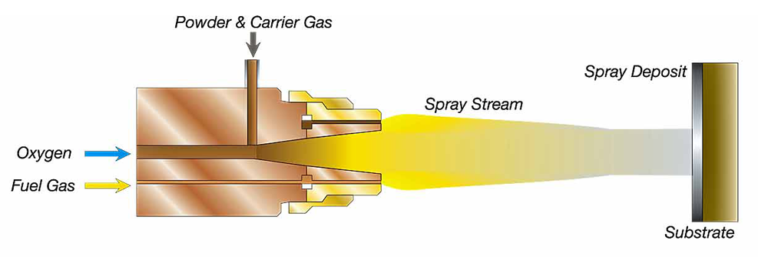Autogenous powder spraying
With powder spraying, also called autogenous powder spraying or powder flame spraying, in an acetylene/oxygen flame with a temperature range of 3,000-3,200°C, the material, which is in powder form, is accurately dosed, melted and atomized to the paper. The operation of the powder spraying installation is not far different from the wire spraying installation.
A large number of metals, alloys and metal compounds can be sprayed under controllable conditions with autogenous powder spraying. This gives a microporous lamellar structure that can be applied relatively cheaply.
If a layer [*] has been applied and it has not had an additional heat treatment (melting), then the layer will have moderate tensile and elongation strength but good compressive strength.
After melting, a metallurgical bond is created with the part and the layer is more resistant to line and point loads and it acquires a homogeneous and closed structure.
Applications
- Seal raceways against the running-in of the seals
- Ball valves to improve wear resistance and chemical protection
- Boiler walls of incinerators against high temperature erosion and chemical attack
- Repairs or dimensional corrections of run-in journals or bearing seats with nickel base alloys
[*] Not all materials that are applied with the autogenous powder spraying process are suitable for an extra heat treatment.
Autogenous Powder Spraying with Fusing
After applying the coating, a certain group of powders, the so-called melt-in alloys, require an additional heat treatment, namely melting or fusing. The melting takes place at a temperature of approximately 1.060°C. In this high temperature range, which both the base material and the spray material undergo, diffusion occurs between coating and base material. The result is a metallurgical compound that is homogeneous in structure.
Positive features
With the powder spraying process a large number of metals, alloys and metal compounds can be sprayed under controllable conditions.
If the part also receives a heat treatment, then these layers are very resistant to line, point or impact loads.
Applicable materials (DIN EN ISO 14920)
- Aluminum alloys
- Nickel
- Chrome alloys
- Chromium boron carbide/ni or co (20-62 HRC)
- Chromium Boron Carbide/Tungsten Carbide (67-70 HRC)
How can we be of service to you?
Do you have a question? Please contact us by filling in the contact form.

